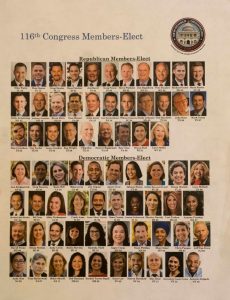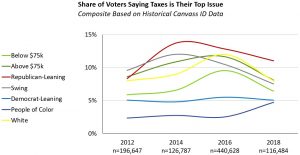As Democrats debate the pros and cons of impeachment, one thing is clear: It’s not like Dems are going to need more anti-Trump publicity — the negative revelations are going to keep on coming, regardless of whether or not Dems impeach him. As Mike Allen reports in “Trump’s World Faces 16 Criminal and Civil Probes” in his Axios AM e-blast: “Post-Mueller, Garrett M. Graff of WIRED reports that Trump’s world “still appears to face 16 known criminal and civil probes, from as many as a dozen different federal, state, and local prosecutors…Four cases are being pursued by federal authorities in New York. … “New York state and local authorities are also building cases, both criminal and civil…These include tax and immigration issues for Trump businesses, plus inauguration spending, the Trump Foundation and the NRA…That’s not counting the dozen cases that the special counsel’s office referred to other law enforcement agencies, cases mentioned in Mueller’s report but redacted so as to obscure any details about them…Why it matters: “At this rate, Trump’s investigations may outlast his presidency…See the list.”
At Campaigns and Elections, Sean J. Miller writes in his article, “Is the Chase for Small-Dollar Donors a Problem for 2020 Democrats” that “In February, the DNC announced that for candidates to get on stage at its two presidential primary debates, they would have to meet certain fundraising criteria. Specifically, they would need to raise money from 65,000 donors in at least 20 different states…We have optimized, because of the 65,000 small-dollar donor debate prerequisite, for low-dollar acquisition right now,” said Shomik Dutta, a partner at Higher Ground Labs, which has funded a slate of political technology startups over the past two cycles. “So every presidential candidate is making a low-dollar argument to coastal activists and what we are missing is the opportunity to do some framing of our general [election] opponent in the states that matter.”
Democrats may want to keep an eye on the latest buzz about “modern monetary theory” (MMT), the big biz version of which is lightly explored in Ben Holland’s “Dalio Says Something Like MMT Is Coming, Whether We Like It Or Not” at Bloomberg.com: “Central banking as we know it is on the way out, and it’s “inevitable” that something like modern monetary theory will replace it, billionaire investor Ray Dalio said…The doctrine, known as MMT, says that governments should manage their economies through spending and taxes — instead of relying on independent central banks to do it via interest rates. It also seeks to allay fears over budget deficits and national debts by arguing that countries like the U.S., which have their own currency, can’t go broke and have more room to spend than is usually supposed — provided inflation is subdued, as it is now…Debate over MMT, which languished in obscurity for decades, has exploded in recent months. The idea has been criticized by a series of financial heavyweights, from Warren Buffett to Federal Reserve Chairman Jerome Powell. But Dalio, the founder of Bridgewater Associates, the world’s biggest hedge fund, said policy makers will have little choice but to embrace it.” Paul Krugman has a more skepical take right here.
In their poorly-titled, but otherwise informative Daily Beast post, “Joe Biden’s Union Pitch Is a Throwback Aimed at White Males,” Scott Bixby and Gideon Resnick take a peek at former Vice President Biden’s working-class outreach strategy. Their observations include this riff on a Biden comment: “I make no apologies: I am a union man, period,” Biden said at his kickoff rally at the Teamsters Local 249 in Pittsburgh on Monday afternoon, to an audience largely composed of union workers. “The country wasn’t built by Wall Street bankers, CEOs and hedge fund managers—it was built by you. It was built by the great American middle class, and the American middle class was built by you, by unions!”…But Biden’s bid to build a strong coalition of union supporters in the primary and beyond has, so far, frequently been focused on largely white, largely male career fields and labor organizations—electricians, firefighters, Teamsters—rather than the nation’s increasingly diverse unionized workforces.” It’s way early, guys. Biden just launched his campaign and he can’t be everywhere at once. He will certainly be reaching out to workers of color and the organizations that represent them.
Noting that “President Donald Trump hits a new high on his economic approval ratings in a new CNN Poll conducted by SSRS, reaching 56% of Americans saying he’s doing a good job on the economy,” CNN’s Grace Sparks adds that “The economy is the President’s best issue tested in the new poll, with his other approval ratings all below 50%. Even among those who disapprove of the way the president is handling his job generally, 20% say they approve of his work on the economy. That’s larger than crossover approval for any other issue by 12 points.” However, Trump usually finds ways to distract media coverage from his better talking points with some new outrage. But Democratic candidates can’t rely on Trump’s distraction du jour; they must have responses that reveal the negative effects of Republican economic policies and the benefits of Democratic alternatives.
At Brookings, Richard V. Reeves has some data-rich responses to recent economic trends Democrats can mine to good effect, including: “In the last few years, as the zombie gradually wakes up, household incomes and wages have begun to nudge upwards – but families are still having to work more hours to get the income they need. Women are working more, and earning more (though the pay gap remains). But as men work less, and earn less, many families are simply standing still in economic terms. Since 1979, the median male wage in the US has dropped by 1.4% for whites– and by 9% and 8% for black and Hispanic men, respectively. Workers at the top of the earnings and education distribution have seen their paychecks continue to fatten: not so on the middle and bottom rungs of the labor market. Wage growth remains torpid in the middle of the distribution…Most American workers are still paid by the hour, and half of them have no formal control over their schedules. Two in five hourly-paid workers aged between 26 and 32 know their schedules less than a week in advance. Hard to arrange childcare on that notice. Many American workers are fighting, like the trade unions of old, on two fronts: for money, and for time.”
And let no Democratic candidate fail to read Heidi Schierholz’s “More than eight million workers will be left behind by the Trump overtime proposal” at The Economic Policy Institute, which notes: “On March 22, 2019, the Department of Labor published a proposal to set the salary threshold under which almost all workers are entitled to overtime pay to $679 per week, or $35,308 for a full-year worker, in 2020.1 The adoption of this proposal would leave behind millions of workers who would have gotten new or strengthened overtime protections under regulations finalized in 2016.2 This analysis compares the economic impact of the Trump administration proposal to the 2016 rule.” Among the key findings: “…The 8.2 million workers left behind by the Trump proposal include 3.1 million workers who would have gotten new overtime protections under the 2016 rule and 5.1 million workers who would have gotten strengthened protections under the 2016 rule…The 8.2 million workers who would be left behind include 4.2 million women, 3.0 million people of color, 4.7 million workers without a college degree, and 2.7 million parents of children under the age of 18…The annual wage gains from workers who get new protections are $1.2 billion dollars less under the Trump proposal than under the 2016 rule…”
An In These Times staff post, “We Desperately Need Medicare for All. These 10 Statistics Prove It,” provides some data ammo as the health care reform debate gathers momentum. A few of their nuggets: “79% – Increased death rate for cancer patients who filed for bankruptcy in 2016…$1,443 – U.S. per capita spending on pharmaceutical costs in 2016, the highest in the world…44% – Americans who didn’t go to a doctor when they were sick or injured because of cost…530,000 – Estimated number of families who file bankruptcy each year due to medical issues and bills…”








